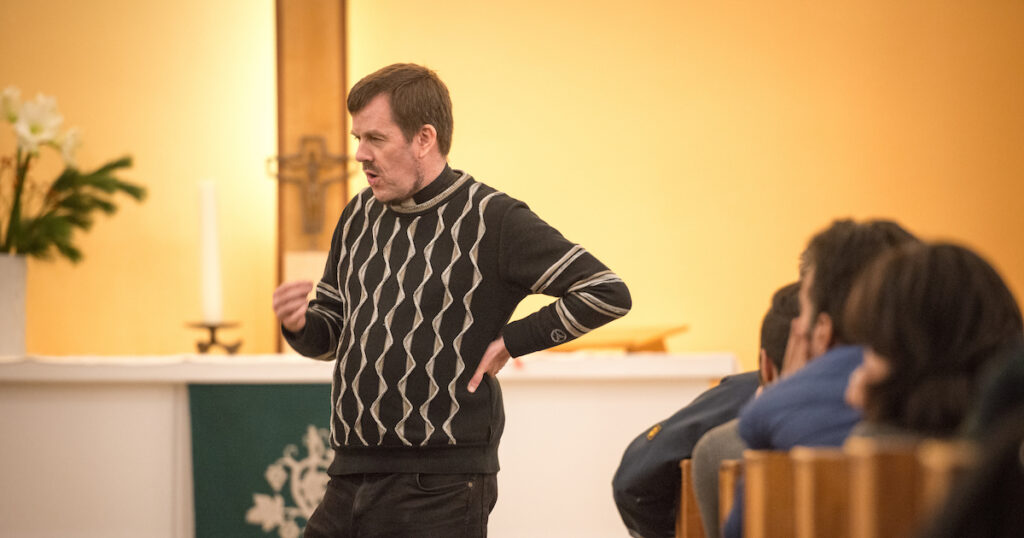By Lyman Stone
As a demographer who studies religious communities, I get one question more than any other: How can churches grow? Despite the many problems surrounding a focus on “church growth” as a goal, I take the question with the earnestness with which it is usually asked. It is a tragedy to see faithful churches close, to see the clear numeric dwindling of Christ’s people in the United States today. While simply getting high numbers to report isn’t the goal of evangelism, there is a very real and faithful sense in which Christians genuinely desire that their congregations should be full of neighbors coming to receive the words which have eternal life.
My answer to the question is equally in earnest: Invite people to church. Across decades of scholarship, it really is the case that there are more converts in churches where more members invite others to church on Sunday or to other church activities. This isn’t rocket science: When the seed of the Gospel is sown in the ears of its hearers, it may sometimes fall on stony soil, but often enough it falls in good soil (Matt. 13:8–9). Scripture tells us clearly that “only God … gives the growth” (1 Cor. 3:7). But it also tells us that those who proclaim the Gospel are “servants through whom you believed, as the Lord assigned. … For we are God’s fellow workers” (1 Cor. 3:5). The Holy Spirit gives the growth, and He uses His people as He does so. In congregations with more members who act as willing instruments of the Spirit’s work, calling people into the body of Christ, it so happens that there tends to be somewhat more positive numeric change.
But as every church worker knows, this answer, while serious, raises more questions than it answers. “Just triple the number of people you invite to church” turns out not to be highly practicable. Sure, you can knock on doors or make cold calls, but those kinds of invitations without relational context turn out to be, while not wholly ineffective, extremely labor- and time-intensive, and thus daunting for clergy or active laymembers with limited time and many other duties. Plus, again, evangelism isn’t just a “numbers game:” inviting more people to church by devaluing the personal care contained in each invitation isn’t a good idea. Setting aside the spiritual question at the root of it, on some level the fundamental social problem of evangelism is just this: How do we create circumstances where more church members feel empowered to talk to their friends about faith and, especially, about checking out their church?
A culture starved for community
Modern life is full of talk about “communities.” Anything can be a community — races or ethnic groups are describes as “communities,” an online chat group is a “community,” the new megachurch down the road probably talks a lot about being a “community,” and in Google’s digital library of most English-language texts from all of history, usage of the word “community” rose 30% between 1985 and 2020. And yet, at the same time, real community life has largely withered away: Membership in almost every kind of American civic life has declined sharply over the last few decades. Even informally, Americans spend about 40% less time with friends in a typical week now than they did 50 years ago. Social media has exacerbated this trend, but it didn’t begin it. Even as Americans have become more and more rhetorically fixated on “community,” their actual communities have been ground down by the onslaught of individualism, television, the all-consuming cradle-to-grave American sports culture (whether dominating our homes on TV, or our schedules for our kids’ travel teams), social media, and any number of other forces of atomizing modernity.
Churches are no exception to this trend. Truthfully, the decline of religion in America is to a considerable extent just a downstream effect of the wider decline in all community life in America. The soil of American society today is just stonier than in the past, not least because a growing number of Americans live isolated lives giving them few of the relationships and connections through which they might otherwise have been invited to a Bible study, a fellowship event, or to the Divine Service. As I’ll describe below, the average LCMS member will extend approximately 1.1 church invitations to a non-member per year: but those invitations will mostly go out to LCMS members’ social contacts. Huge chunks of modern American society have few or no social contacts at all; figuring out how to “invite” them is no simple task. At about 1 church invitation per LCMS member per year, we also have to ask: What share of our members’ relational contacts never in their lives got an invite? How many people lived lives of quiet spiritual suffering while their LCMS neighbor couldn’t quite figure out the right way to invite them to church? I do not ask this to be down on our church members — we are all limited people, and inviting people to church can indeed be socially fraught.
The key point, however, is just this: Modern Americans are starved for community. They talk about community all the time, but live lives of isolation and loneliness. Once you realize that American life has been fundamentally transformed in this particular way, namely, that most people today simply do not have many meaningful interactions with others, have few close friends, and have almost no actual personal experience of functional community life, it’s easier to understand a lot about our society. This also helps us to see where there may be an opening for evangelism.
The best evangelism? Love one another
How do you get people without communities connected to a church? How do you inspire LCMS members to feel confident inviting their friends into the true community that is the church?
Empirically, there’s an answer to these questions. The 2023 Lutheran Religious Life Survey asked about 2,000 current LCMS members a range of questions about their opinions, their life stories and their churches. One simple fact shone through: One of the best predictors of evangelistic behavior (meaning inviting people to church, discussing your faith with people who don’t share it, or mentioning Lutheranism when meeting new people) was the frequency with which the respondent spent social time with fellow church members. LCMS members who socialize with other church members a lot reported doing quite a lot of evangelistic behavior. LCMS members who don’t socialize with other church members did far less. Even after controlling for extraversion as a personality trait and personal beliefs about the importance of evangelism, LCMS laypeople who reported approximately weekly-or-more frequency of hanging out with other church members outside of church had almost double the frequency of evangelistic behaviors as LCMS laypeople who rarely or never socialized with other church members. Relatedly, LCMS members who reported being proud of their congregation were also likelier to invite others into it.
These findings may seem counterintuitive: How can it be that the Lutherans most focused on socializing with other Lutherans are the same people doing the most evangelism? But the answer is surprisingly obvious: People are eager to invite people into communities they like, and not into communities they don’t. If you think your fellow church members are wonderful people to spend an evening with, you’re likely to hang out with them. You’re also likely to invite your non-church friends to hang out with them. Maybe at a Reformation Day bonfire, your non-Christian friend will meet your pastor, and have a long overdue conversation. Maybe the new family that moved in down the block will join the regular playgroup with several church member families, and start attending church so their child can join the Sunday school. As church members socialize together, this creates social spaces that make invitation easy, and bridges the social gap into the church community. The first invite doesn’t have to be the Divine Service (which isn’t generally designers for “seekers” anyways), but can instead be to a party, or dinner, or other lower-stakes activity.
Any sociologist who studies networks and groups will back this up, and in fact research by sociologist Rodney Stark and other scholars suggests exactly this kind of social-bridging can explain much of the rise of early Christianity. These kinds of gravitational ties, where people outside of a group get linked into its orbit, then drawn ever-more-deeply-in by growing social ties, are pretty much universal to human social life. God has written our desire for community deeply into our hearts. Social ties are not the same thing as faith, but they do bring people into more social contact with Christians — and hopefully, into the Divine Service — where they will hear the Word of God proclaimed to them. Church is not a social club — yet the “mutual conversation and consolation of the brethren” (Smalcald Articles IV) is a vital part of what it is for a group of people to truly be an ecclesia. And unlike the worldly social ties that might lead someone into lies, social ties drawing our neighbors into greater fellowship with Lutherans give the opportunity for “faith [to come] from hearing” (Rom. 10:17): whether in mealtime prayers socializing over dinner, bedtime prayers for kids before a game night for the parents, hymns sung on a camping trip, or an eventual visit to the Divine Service.
If we want to see more invitation, the path to that is not just this or that new evangelism curriculum, or a powerful exhortation in a sermon, or a special Sunday school series: The path runs through cookouts and going to the zoo and visiting retirement homes and high school musicals. They will know that we are Christian by our love — for the world at large, yes, but most especially for one another. When we love one another, when we live our social life outside of church as if we actually like one another and our church, our neighbors can tell.
And indeed, this is the model Jesus Himself demonstrated. How many of those who followed Him knew His doctrine first? Few. Most who followed our Lord first knew Him as a healer, or as a friend of sinners, or a prophet, or the man who fed them, or a guy at a wedding — they fell in love with the man, and so were prepared by His works of love to receive the His life-giving Words.
Statistically, this is how it often works for LCMS churches too. In the Lutheran Religious Life Survey, less than a third of converts to the LCMS reported that our doctrines were a key factor in why they first walked through our doors: they first came through a wide variety of social ties, and then learned our doctrine. When our churches are genuine communities of love where people pour into one another’s lives outside of Sunday, those congregations have higher rates of invitation, higher likelihood of having recent converts, and (though survey data on this is imprecise), very likely more positive change in congregational numbers.
This is not some snake-oil church growth equation: “just add some church cookouts and watch the new members pour in!” Rather, it is a timeless truth, that communities confident in what they are offering are more convincing to those around them. Churches that wish to draw others in would do well to be bold, confident communities with a distinctive way of life, including a distinctively committed social life together. And we have every reason to be bold and confident, since what we offer is the very Word, and the very body and blood, of the Son of God.
Cover image: LCMS/Erik M. Lunsford






Very informative & thoughtful analysis.
RE: “When our churches are genuine communities of love….”
How can congregations best make an assessment along these lines and, upon recognizing opportunities for improvement, pursue them cheerfully? An internet search for “assessing church health” returns a number of approaches.
And even a little bit of individual initiative can make a difference. There can be joy in simply looking for ways to be a blessing to someone else before or after each worship service — deliberately taking an interest in someone new, asking how they are doing, and listening well for at least a few moments.
And let us consider how to stir up one another to love and good works, not neglecting to meet together, as is the habit of some, but encouraging one another, and all the more as you see the Day drawing near (Heb. 10:24-25 ESV).
It seems to me that the kind of interaction depicted in that Bible verse is not merely an incidental result of being in the same sanctuary at the same time for worship. Rather, it is a loving exhortation to be sure to engage one another helpfully and even creatively so as to increase hope in God and fulfill our calling, to our joy and His glory.